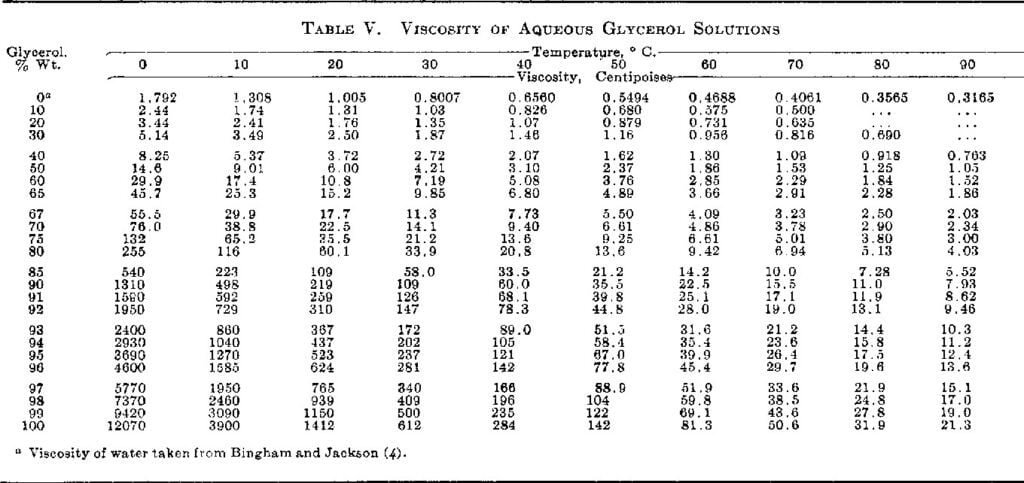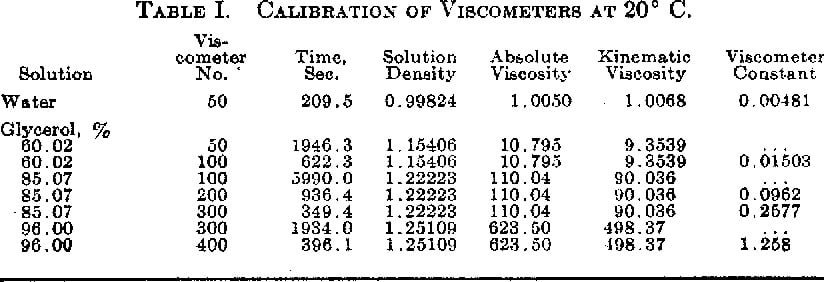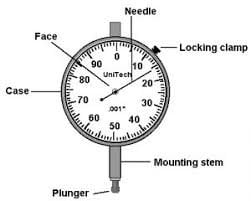The viscosity of glycerol is a crucial characteristic that impacts its use in various industrial applications. Viscosity is a measure of a fluid’s resistance to flow and is a fundamental property of many materials, including glycerol. Understanding glycerol’s viscosity and how it relates to its practical applications is essential for optimizing processes and achieving desired outcomes in different industries.
In this article, we will explore the viscosity of glycerol in-depth. We will start by providing a solid understanding of viscosity and how it is measured. Then, we will delve into the factors that affect glycerol’s viscosity, such as temperature, pressure, and concentration.
Next, we will examine the importance of viscosity in numerous industries, including food processing, cosmetics, and pharmaceuticals. We will also discuss the measurement techniques used to determine glycerol’s viscosity and highlight real-world applications of glycerol’s viscosity in various industries.

Understanding Viscosity
Viscosity is a measure of a fluid’s resistance to deformation or flow. In other words, it refers to how sticky or thick a fluid is. Understanding the concept of viscosity is essential for comprehending its importance in various industries.
Viscosity is typically measured in units called poise or centipoise. The poise unit is defined as the force required to move a surface of area 1 cm² at a velocity of 1 cm/s, with the surface being separated by a fluid layer of 1 cm in thickness. Centipoise is one-hundredth of a poise, and it is commonly used for measuring the viscosity of liquids such as glycerol.
Viscosity can be influenced by several factors, including temperature, pressure, and concentration. The temperature has a significant impact on viscosity, with most liquids becoming less viscous as they are heated. In contrast, an increase in pressure typically increases the viscosity of a fluid.
Factors Affecting Viscosity
Viscosity is influenced by several factors, and glycerol is no exception. It is crucial to understand how these factors affect the viscosity of glycerol to optimize processes and achieve desired results.
Temperature: One of the most significant factors that affect the viscosity of glycerol is temperature. Generally, an increase in temperature leads to a decrease in viscosity, while a decrease in temperature leads to an increase in viscosity. This phenomenon occurs because higher temperatures increase the kinetic energy of the glycerol molecules, allowing them to move more freely and reducing the resistance to flow.
Pressure: The pressure exerted on glycerol also plays a role in its viscosity. As pressure increases, the molecules are forced closer together, causing more interaction between them and increasing viscosity. Conversely, as pressure decreases, the molecules move further apart, leading to decreased viscosity.
Concentration: Another factor that affects the viscosity of glycerol is concentration. As the concentration of glycerol increases, so does its viscosity. This phenomenon occurs because higher concentrations of glycerol increase the amount of intermolecular forces between molecules, resulting in more resistance to flow.
Understanding these factors is essential for predicting the behavior of glycerol in various industrial applications. By manipulating these factors, manufacturers can alter the consistency of glycerol to achieve desired results in their products.
Importance of Viscosity in Industrial Applications
Viscosity plays a crucial role in numerous industrial applications. It impacts processes such as mixing, flow, and separation, making it an essential consideration in product development and manufacturing. Understanding viscosity is critical for optimizing industrial processes and achieving desired outcomes.
In the food processing industry, viscosity determines the texture and consistency of products such as sauces, dressings, and beverages. In cosmetics, viscosity affects the spreadability and thickness of creams, lotions, and gels. In the pharmaceutical industry, it affects drug delivery and formulation. Viscosity is also essential in the production of lubricants, where it ensures proper flow and reduces wear and tear.

Viscosity of glycerol
Glycerol is an exceptional substance when it comes to viscosity. At room temperature (approximately 25°C or 77°F), glycerol is much more viscous than water, making it a thick and syrupy liquid. The high viscosity of glycerol can be attributed to its molecular structure. Glycerol molecules have three hydroxyl (OH) groups, which create strong hydrogen bonds between adjacent molecules. These hydrogen bonds lead to a high degree of molecular cohesion, resulting in increased viscosity.
Temperature also plays a significant role in glycerol’s viscosity. As the temperature increases, the kinetic energy of the glycerol molecules also increases, weakening the hydrogen bonds. This decrease in intermolecular forces causes glycerol to become less viscous, making it more fluid at higher temperatures.
Measurement Techniques for Glycerol Viscosity
Determining the viscosity of glycerol requires specific measurement techniques. The following are some common methods used to measure the viscosity of glycerol:
- Viscometers: These are devices that measure the time it takes for a fluid to flow through a fixed volume. There are various types of viscometers used to measure glycerol viscosity, such as capillary, rotational, and falling ball viscometers. Capillary viscometers measure the time it takes for the fluid to pass through a small-diameter tube, while rotational viscometers measure the torque required to rotate a spindle in the fluid. Falling ball viscometers measure the rate at which a ball falls through the fluid.
- Rheometers: These devices measure the deformation of a fluid under stress. The two primary types of rheometers used to measure glycerol viscosity are rotational and oscillatory rheometers. Rotational rheometers measure the torque required to rotate a spindle in the fluid, while oscillatory rheometers measure the strain and stress of the fluid as it oscillates.
- Ostwald Viscometer: This type of viscometer is specifically designed to measure the viscosity of liquids such as glycerol. The device consists of a U-shaped tube with a bulb at the center and two marks on the tube. The time it takes for the fluid to flow between the two marked points is measured, and the viscosity is calculated accordingly.
These measurement techniques provide accurate and reliable data on the viscosity of glycerol and are crucial for optimizing industrial processes that employ glycerol.
Practical Applications of Glycerol Viscosity
Glycerol’s viscosity properties have numerous practical applications in various industries. Let’s take a closer look at some real-world examples:
- Cosmetics: Glycerol is widely used as a moisturizer in various cosmetic products due to its ability to hydrate the skin. Its thickening properties also make it a common ingredient in lotions, creams, and gels that require a smooth and silky texture.
- Pharmaceuticals: Glycerol is used as a solvent and preservative in various pharmaceutical products. Its viscosity properties make it useful in suspending insoluble drugs in liquid form and controlling their release rate.
- Food and Beverage: Glycerol’s viscosity makes it an essential ingredient in food processing. It is used as a thickening agent, humectant, and sweetener in various products such as baked goods, dairy products, and beverages. It also helps prevent ice crystals from forming in frozen foods.
Moreover, glycerol’s viscosity properties make it an excellent lubricant for various industrial applications. Its ability to maintain a consistent viscosity under different temperature and pressure conditions makes it ideal for use in hydraulic fluids, brake fluids, and engine oils.
Conclusion
In conclusion, the viscosity of glycerol is an essential characteristic, impacting its functionality in various industrial applications. Understanding the viscosity of glycerol and the factors affecting it is crucial for optimizing processes and achieving desired outcomes in different industries.
By understanding the viscosity of glycerol, industries can develop new and innovative products that meet the needs of consumers. The food and beverage, cosmetics, and pharmaceutical industries all benefit from the unique viscosity properties that glycerol offers.
Accurate measurement techniques such as viscometers and rheometers help in determining the viscosity of glycerol. In this way, the industries can ensure the quality and performance of their products.
The viscosity of glycerol is crucial in developing high-quality lubricants that can withstand extreme temperature and pressure. Additionally, it plays an essential role in the cosmetics industry, ensuring that the products have the desired consistency and texture, and the pharmaceutical industry, where it is used to formulate various medicines.
In summary, glycerol’s viscosity is a critical property that impacts various areas, including food processing, cosmetics, pharmaceuticals, and lubricants. Understanding the viscosity of glycerol and its influencing factors is vital for optimizing processes and achieving desired outcomes in different industries.
FAQ : Viscosity of Glycerol
What Is Viscosity?
Viscosity refers to the measure of a fluid’s resistance to flow. It determines how easily or difficultly a fluid can be poured or moved. The higher the viscosity, the thicker the fluid.
Why is viscosity important?
Viscosity is crucial because it affects the performance and behavior of fluids in various applications. It determines how efficiently a fluid can flow through pipes or machinery, affects mixing and blending processes, and impacts the stability and texture of products.
Why Is Viscosity Important?
Viscosity is crucial because it affects the performance and behavior of fluids in various applications. It determines how efficiently a fluid can flow through pipes or machinery, affects mixing and blending processes, and impacts the stability and texture of products.
How does viscosity relate to glycerol?
Glycerol is known for its relatively high viscosity compared to other liquids. Its viscosity provides desirable properties in applications such as lubricants, cosmetics, and pharmaceuticals.
What factors affect the viscosity of glycerol?
Several factors influence the viscosity of glycerol, including temperature, pressure, and concentration. Higher temperatures generally reduce the viscosity, while higher pressures and higher glycerol concentrations increase viscosity.
Why is viscosity important in industrial applications?
Viscosity is vital in industrial applications as it affects processes such as pumping, mixing, and coating. In fields like food processing, cosmetics, pharmaceuticals, and lubricants manufacturing, viscosity plays a crucial role in achieving desired product quality and performance.
How Is The Viscosity Of Glycerol Measured?
The viscosity of glycerol can be measured using viscometers or rheometers. These instruments apply controlled forces and measure the resulting fluid flow or deformation. Common units for viscosity measurement include pascal-seconds (Pa·s) or centipoise (cP).
What Are Some Practical Applications Of Glycerol Viscosity?
Glycerol’s viscosity properties find practical applications in various industries. It is used as a thickening agent in cosmetics, a solvent and humectant in pharmaceuticals, and a viscosity modifier in food and beverage products. It also serves as a lubricant in certain industrial processes.
Check Out Other Important Topics
| IC Engine | Important PDFs | Boilers | Synergy Maritime Exam | Naval Arch | MEO Class 4 |
| Interview Questions | Difference Between | Types of Pumps | Auxiliary Machines | Types of Valves | Home |



